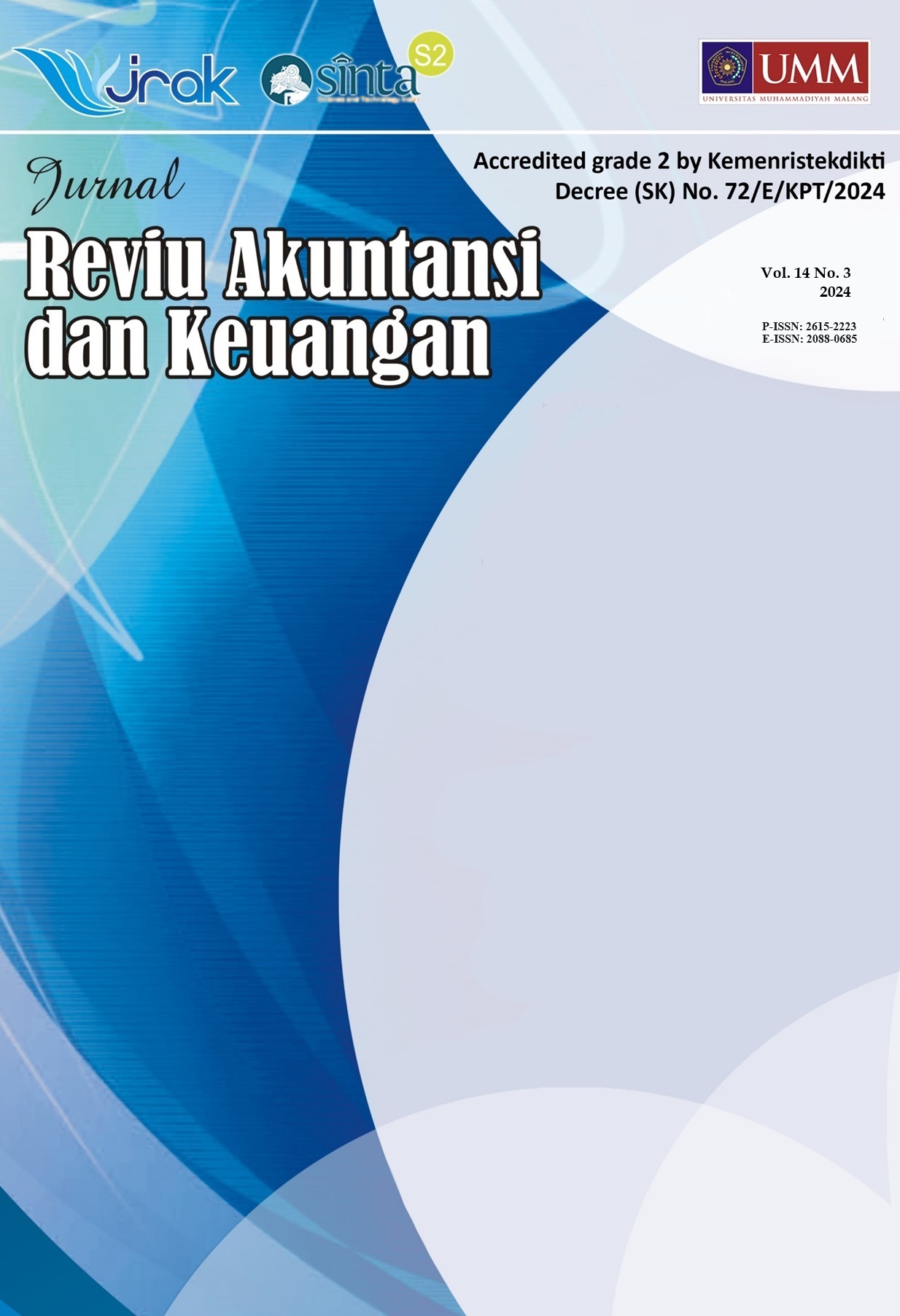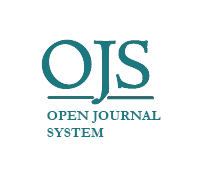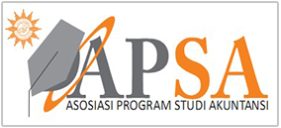Subsequent Measurement for Investment Property: Fair Value Model
DOI:
https://doi.org/10.22219/jrak.v14i3.29608Keywords:
Fair Value Method, FIRM SIZE, Gain from Revaluation, information asymmetry, LeverageAbstract
Purpose: This study examines the effect of firm size, leverage, gain from revaluation, and information asymmetry on the possibility of choosing a fair value method of investment property moderated by institutional ownership.
Methodology/approach: The quantitative research method with logistic and moderated regression analysis. The number of samples in this study was 117 companies. The final observation data during the 2018-2022 period was 585 firm years.
Findings: The study's results proved that firm size and gain from revaluation affect the selection of the fair value method of investment property. In comparison, leverage and information asymmetry do not affect the selection of fair-value methods of investment property. In addition, institutional ownership can only moderate the effect of information asymmetry on selecting fair-value methods of investment property.
Practical implications: The small number of companies that do not yet use fair value to measure investment properties can be used as material for consideration by the Financial Accounting Standards Drafting Board to improve regulations related to the use of fair value of investment properties. Companies can take this into account when choosing the best approach to ensure that financial statement readers can utilize them as a foundation for decision-making.
Originality/value: Adding the gain from revaluation as opportunistic motivation as the independent variable and institutional ownership as moderation variables.
Downloads
References
Agustia, D. (2013). Pengaruh Faktor Good Corporate Governance, Free Cash Flow, dan Leverage terhadap Manajemen Laba. Jurnal Akuntansi Dan Keuangan, 15(1), 27–42. https://doi.org/10.9744/jak.15.1.27-42
Alves, S. (2019). Accounting for Investment Property: Determinants of Accounting Policy Choice by Portuguese Listed Firms. International Journal of Accounting and Taxation, 7(2), 1–10. https://doi.org/10.15640/ijat.v7n2a1
Arlita, R., Bone, H., & Kesuma, A. I. (2019). Pengaruh Good Corporate Governance dan Leverage terhadap Praktik Manajemen Laba. Akuntabel, 16(2), 238–248. https://doi.org/https://doi.org/10.21067/jrma.v6i2.4218
Cairns, D., Massoudi, D., Taplin, R., & Tarca, A. (2011). IFRS Fair Value Measurement and Accounting Policy Choice in the United Kingdom and Australia. Elsevier, 43(1), 1–21. https://doi.org/10.1016/j.bar.2010.10.003
Diella, N., & Pakpahan, E. (2022). Analisis Pengaruh ROE dan DAR Terhadap Harga Saham ( Studi Kasus pada PT PP Properti Tbk Periode 2016-2020 ). Indonesian Journal of Economics and Management, 2(3), 614–620. https://doi.org/https://doi.org/10.35313/ijem.v2i3.3191
Feghali, K., Jreije, R., & Bahnan, N. (2023). Suitability Relevance of The Fair Value Measurement under IFRS 13 Vs Historical Cost: Application to The Lebanese Banking Sector. International Journal of Accounting&business Finance, 9(1), 1–26. https://doi.org/DOI:10.4038/ijabf.v9i1.131
Fitriani, A. (2018). Pengaruh Profitabilitas, Ukuran Perusahaan, dan Financial Leverage terhadap Praktik Perataan Laba (Income Smoothing) pada Perusahaan Farmasi yang Terdaftar di Bursa Efek Indonesia Periode 2011-2015. Jurnal Samudra Ekonomi Dan Bisnis, 9(1), 50–59. https://doi.org/10.33059/jseb.v9i1.461
Hagerman, R. L., & Zmijewski, M. E. (1979). Some Economic Determinants of Accounting Policy Choice. Elsevier, 1(2), 141–161. https://doi.org/10.1016/0165-4101(79)90004-1
IAI. (2008). Exposure Draft Pernyataan Standar Akuntansi No. 13. IAI.
Kadri, M. H., Amin, J. M., & Bakar, Z. A. (2020). Investment property, Cost Model, Fair Value Model and Value Relevenve: Evidence from Malaysia. International Journal of Financial Research, 11(3), 115–124. https://doi.org/10.5430/ijfr.v11n3p115
Mita, A. F., & Siregar, S. V. (2019). The Use of The Fair Value Accounting Method for Investment Property in Indonesia. Pertanika Journal of Social Sciences and Humanities, 27(1), 195–212. Retrieved from pertanika.upm.edu
Muller, K. A., & Riedl, E. J. (2008). Causes and Consequences of Choosing Historical Cost versus Fair Value. Harvard Business School, June, 49. Retrieved from researchgate.net
Mulyanti, S. P. S., Darmayanti, Y., & Yunilma, Y. (2020). Kemungkinan Pemilihan Metode Nilai Wajar bagi Perusahaan yang Melaporkan Properti Investasi. Jurnal Kajian Akuntansi Dan Bisnis Terkini, 3(1), 438–457. https://doi.org/10.31258/jc.1.1.21-35
Musyafa, K. A., & Kholilah, K. (2023). Cash Holding, Financial Leverage, Profitability, Firm Size, Income Smoothing: Moderating Managerial Ownership. E-Jurnal Akuntansi, 33(4), 1085. https://doi.org/10.24843/eja.2023.v33.i04.p15
Nagar, V., Schoenfeld, J., & Wellman, L. (2019). The effect of economic policy uncertainty on investor information asymmetry and management disclosures. Journal of Accounting and Economics, 67(1), 36–57. https://doi.org/10.1016/j.jacceco.2018.08.011
Olante, M. E., & Lassini, U. (2022). Investment property: Fair value or cost model? Recent evidence from the application of IAS 40 in Europe. Advances in Accounting, 56(March 2020), 100568. https://doi.org/10.1016/j.adiac.2021.100568
Pratiwi, A. D., & Karundeng, F. E. F. (2023). Relevansi Nilai Pengukuran Nilai Wajar Aset Non-Keuangan. Balance : Jurnal Akuntansi Dan Manajemen, 2(1), 40–47. https://doi.org/10.59086/jam.v2i1.270
Pratiwi, M., & Siswantoro, D. (2018). Pengaruh Akuntansi Nilai Wajar Terhadap Manajemen Laba: Peran Moderasi Status Perusahaan Dalam Indeks Saham Syariah Indonesia. Jurnal Ilmiah Akuntansi, 2(2), 191–213. https://doi.org/10.23887/jia.v2i2.15637
Pratiwi, M. W., & Tahar, R. S. (2017). Analisis Pengaruh Tingkat Hutang, Ukuran Perusahaan, Informasi Asimetri, Selisih Keuntungan Nilai Wajar, dan Kepemilikan Saham terhadap Pemilihan Metode Nilai Wajar pada Properti Investasi. Media Riset Akuntansi Vol.7, 7(1), 101–119. Retrieved from journal.bakrie.ac.id
Putri, F. R., & Kholilah, K. (2023). Earning Management Determinants: Does Fair Value Accounting Matter? Jurnal Akuntansi Manado (JAIM), 4(1), 27–37. https://doi.org/10.53682/jaim.vi.5878
Sakawa, H., & Watanabel, N. (2020). Institutional ownership and firm performance under stakeholder-oriented corporate governance. Sustainability (Switzerland), 12(3). https://doi.org/10.3390/su12031021
Sari, R. S., Yulinartati, & Aspirandi, R. M. (2020). Faktor-Faktor yang Mempengaruhi Kemungkinan Perusahaan Memilih Metode Nilai Wajar yang Terdapat di Bursa Efek Indonesia. Repository Universitas Muhamadiyah Jember, 13. Retrieved from repository.unmuhjember.ac.id
Setijaningsih, H. T., Handoyo, S. E., & Sundari, N. (2021). Factors Affecting The Selection of Fair Value Methods for Investment Property. Jurnal Organisasi Dan Manajemen, 17(1), 111–129. https://doi.org/10.33830/jom.v17i1.1052.2021
Siregar, S. V., & Utama, S. (2008). Type of Earnings Management and The Effect of Ownership Structure, Firm Size, and Corporate-Governance Practices: Evidence from Indonesia. International Journal of Accounting, 43(1), 1–27. https://doi.org/10.1016/j.intacc.2008.01.001
Vedanti Pratiwi, I. I., Badera, I. D. N., & Budiartha, I. K. (2018). Kemampuan Kepemilikan Institusional Memoderasi Pengaruh Diversitas Gender, Kebangsaan, Pengalaman Dewan Pada Luas Intellectual Capital Disclosure. E-Jurnal Ekonomi Dan Bisnis Universitas Udayana, 2, 543. https://doi.org/10.24843/eeb.2018.v07.i02.p09
Wahyuni, E. T., Soepriyanto, G., Avianti, I., & Naulibasa, W. P. (2019). Why Companies Choose the Cost Model Over Fair Value for Investment Property? Exploratory Study on Indonesian Listed Companies. International Journal of Business and Society, 20(1), 161–176. Retrieved from researchgate.net
Wardhani, W. K., & Samrotun, Y. C. (2020). Pengaruh Kepemilikan Institusional, Kepemilikan Manajerial, Ukuran Perusahaan dan Leverage terhadap Integritas Laporan Keuangan. Jurnal Ilmiah Universitas Batanghari Jambi, 20(2), 475. https://doi.org/10.33087/jiubj.v20i2.948
Watts, R. L., & Zimmerman, J. L. (1990). Positive Accounting Theory: A Ten Year Perspective. The Accounting Review, 65(1), 131–156. https://doi.org/http://dx.doi.org/10.2139/ssrn. 1027382
Yennisa, Y., Juwiyanto, S., & Budiarto, D. S. (2020). Factors in Determining the Preference of Fair Value Method of Investment Property. Jurnal Akuntansi Kontemporer, 12(2), 68–76. https://doi.org/10.33508/jako.v12i2.2210
Yuliana, I., & Kholilah, K. (2019). Diversity of the Executive Board, Investment Decisions, and Firm Value: Is Gender Important in Indonesia? Jurnal Reviu Akuntansi Dan Keuangan, 9(3), 387. https://doi.org/10.22219/jrak.v9i3.10019
Downloads
Published
Issue
Section
License
Copyright (c) 2024 Ayu Rinelisa Prabandari, Kholilah Kholilah

This work is licensed under a Creative Commons Attribution-NonCommercial-ShareAlike 4.0 International License.

Jurnal Reviu Akuntansi dan Keuangan is licensed under a Creative Commons Attribution-NonCommercial-ShareAlike 4.0 International License.
Authors who publish with this journal agree to the following terms:
- Authors retain copyright and grant the journal right of first publication with the work simultaneously licensed under a Creative Commons Attribution-NonCommercial-ShareAlike 4.0 International License that allows others to share the work with an acknowledgement of the work's authorship and initial publication in this journal.
- Authors are able to enter into separate, additional contractual arrangements for the non-exclusive distribution of the journal's published version of the work (e.g., post it to an institutional repository or publish it in a book), with an acknowledgement of its initial publication in this journal.
- Authors are permitted and encouraged to post their work online (e.g., in institutional repositories or on their website) prior to and during the submission process, as it can lead to productive exchanges, as well as earlier and greater citation of published work (See The Effect of Open Access).










